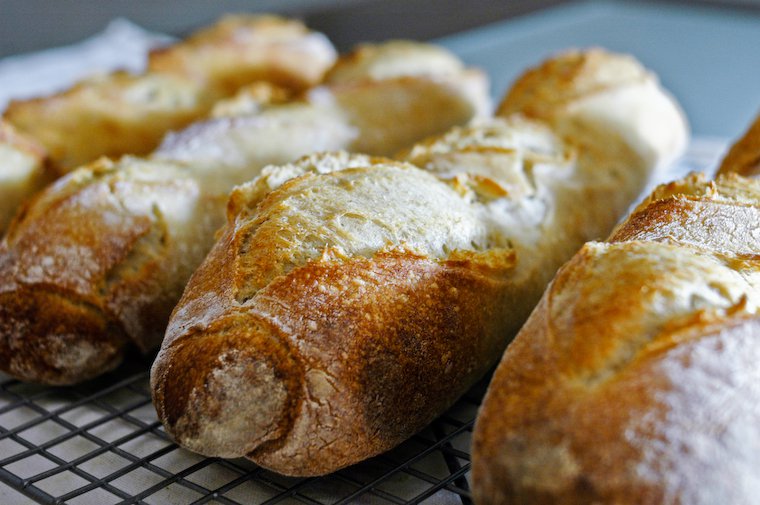[Baguettes au levain]
When I started to bake bread on a weekly basis, I thought following a baguette recipe was out-of-reach territory: I would bake the kind of loaves I love — a hearty crust (but not too dark at the bottom), an open crumb (but one that’s still tight enough to withstand a good spread of dairy or almond butter), great flavor from a slow fermentation, and a nutritious blend of organic flours — but I would always go and get my Piccola baguette from the Coquelicot bakery on place des Abbesses.
After a while though, having baked enough boules (round loaves) in a closed vessel (a pyrex cocotte in my case) to become really good friends with my starter, I decided to graduate to baking bread on a stone.
From the very first attempt, the result was squeal-worthy: a good oven spring, crunchy tips and crust, a crumb that feels springy and alive and, more important, a fragrant and flavorful bread.
A baking stone is fantastic for bread-baking: it absorbs heat as the oven preheats and retains it even as you open and close the oven door, which prevents the temperature in the oven from dropping dramatically when you put in the loaves. Additionally, bread dough that is plopped on a very hot surface rises beautifully: instead of spreading out first, then rising up, it seems a lot more motivated to rise upward from the moment it hits the blazing hot stone (I would too).
My first loaves on the baking stone were free-form bâtards — elongated oval loaves — because it was easier to fit two of those on my square baking stone, and I noticed that the crumb was more open than what I got when baking boules. I made a few more of those, and then I thought, what are baguettes if not thin bâtards? And why didn’t I just make baguettes?
Perfecting the baguette recipe
The baguettes one buys in French bakeries are rarely leavened with a natural starter, and when they are (baguette au levain), the starter is generally coupled with commercial yeast (it is worth asking). The flour that is used is a white wheat flour that often contains additives, and both of these characteristics account for their particularly light, aerated crumb.
What I wanted, on the other hand, was a baguette leavened with a natural sourdough starter only, made with a blend of organic flours that included some partially whole wheat, so I knew I wouldn’t get quite the same texture, but it would be a baguette in its own right.
After reading the reports of fellow starter enthusiasts for tips, and watching a few shaping videos, I felt about ready.
And indeed, from the very first attempt, the result was squeal-worthy: a good oven spring had pulled the slashed slits wide open, the tips and crust were crunchy enough that, when squeezed, the baguettes let out that delightful crackling sound, the crumb felt springy and alive, it was full of holes of various sizes and, more important, fragrant and flavorful.
I wish I could bottle the feeling I get when I watch my baguettes rise through the oven door, then super-peel them out and listen to them chirp as they cool.
I have baked a number of batches since that day, and if I could bottle the feeling I get when I watch my baguettes rise through the oven door, then super-peel them out and listen to them chirp as they cool, I would pose a major threat to antidepressant manufacturers.
We do, however, continue to go out and buy baguettes from Coquelicot on a regular basis, especially when we have friends over: as tickling as it would be to serve a meal that’s homemade right down to the baguettes, it’s just not realistic for me to cook dinner and bake bread on the same day — not if I want to stay awake throughout the evening anyway. But home-baked bread makes quite an impression as a host(ess) gift, I’ve noticed, so that’s my favored way of sharing.
Tips for making this baguette recipe
I should note that my baguettes are, in fact, demi-baguettes (half-baguettes), due to the limited width of my home oven. You can make them slimmer and call them ficelles or flûtes (literally, strings or flutes), if you prefer, dividing the dough into six rather than four pieces, but then you’ll have to bake them in batches, otherwise they won’t have enough elbow room for optimal air circulation. Conversely, you can divide the dough into just two pieces to make bâtards. In all cases, remember to adjust the baking time to the size of the loaves.
Because the dough needs to rest in the fridge for 12 to 24 hours, it means you can really make it work within your own schedule: I generally feed my starter in the morning on day 1, make the dough in the afternoon when the starter is ripe, then bake the baguettes in the morning or in the afternoon on day 2.








